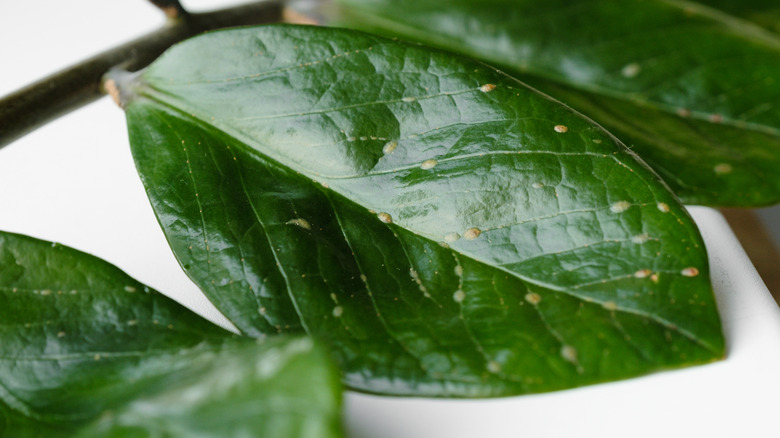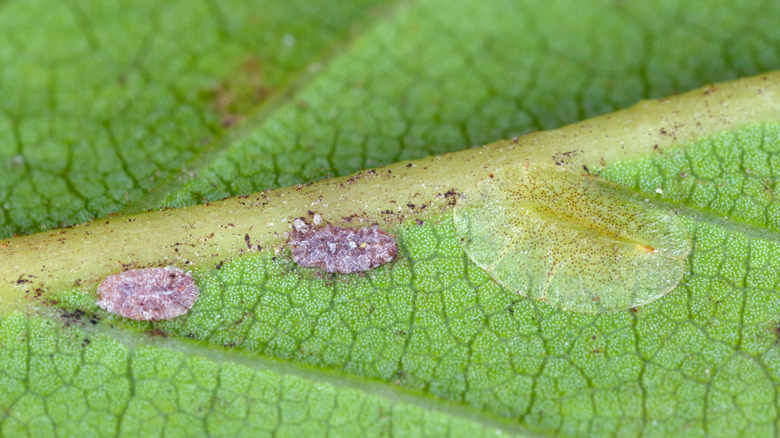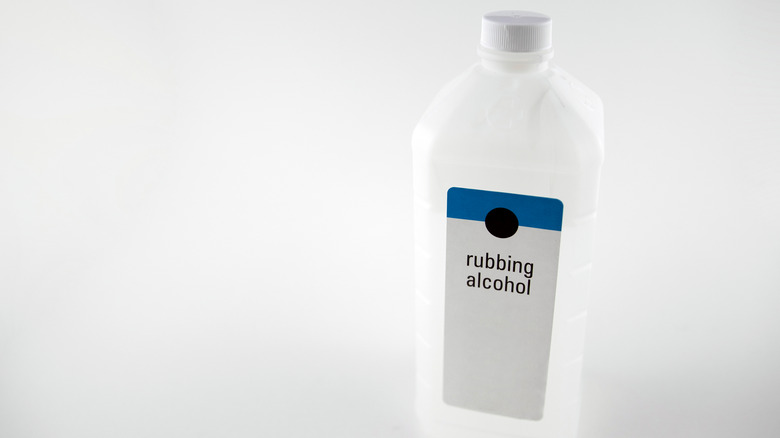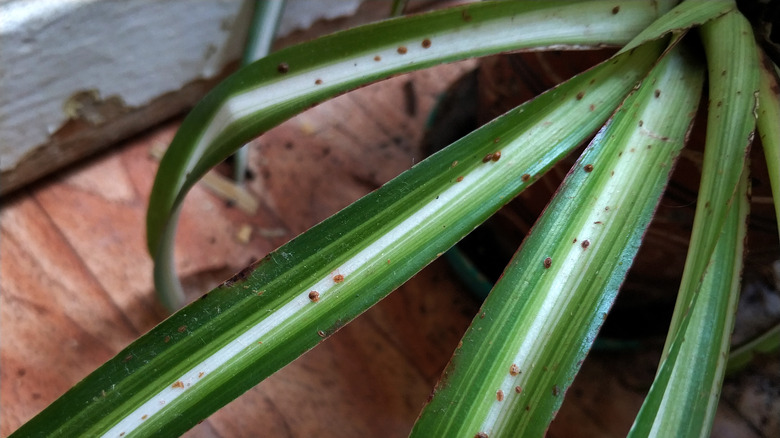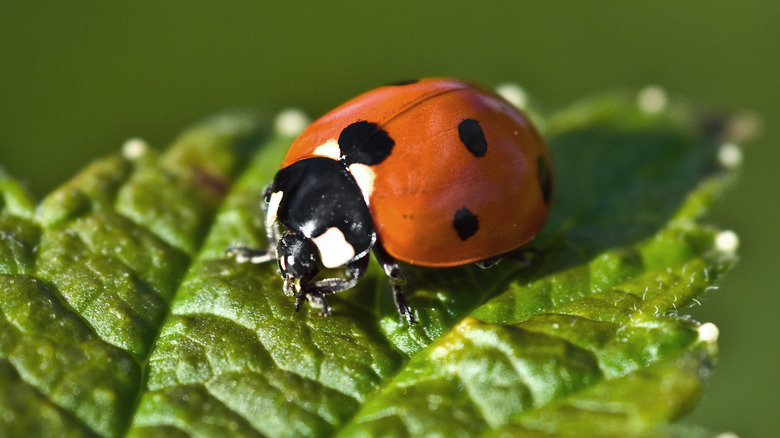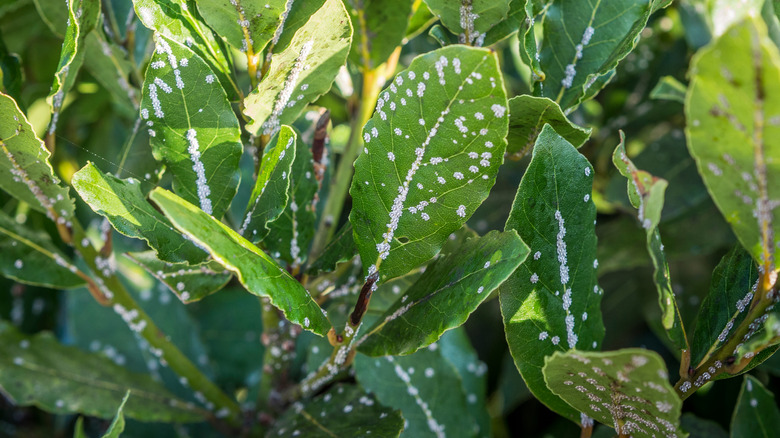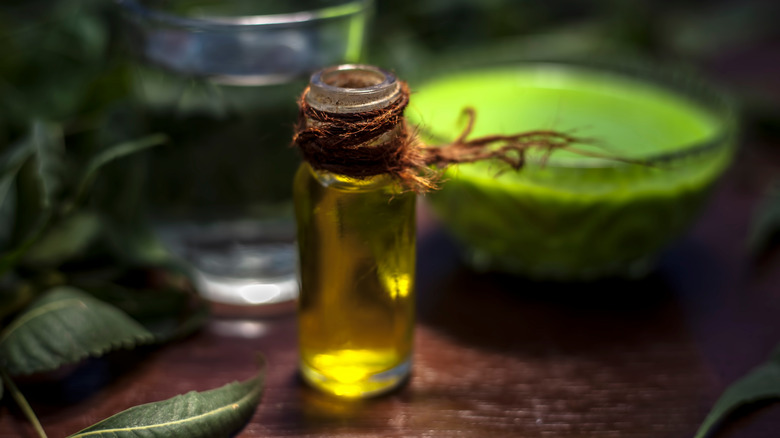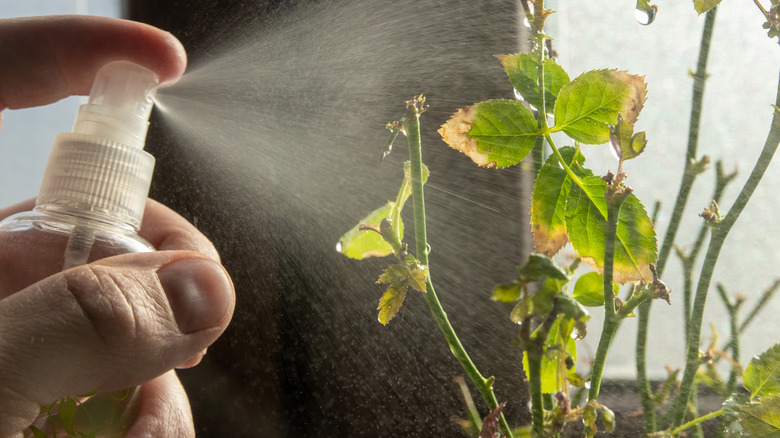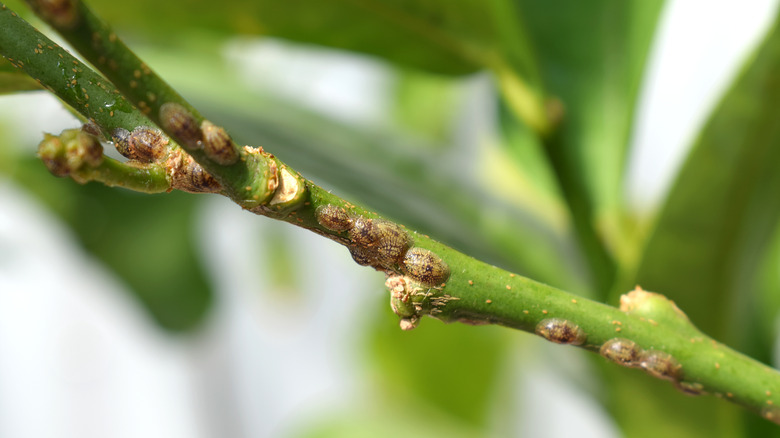8 Best Ways To Get Rid Of Scale On Plants
You've probably encountered scale on your plants a handful of times before, but many people don't even realize that the plant problem isn't just some sort of growth wreaking havoc — it's actually a cluster of nearly microscopic insects. Ew, right?
Per Get Busy Gardening, plant scale bugs are often mistaken for a mold or bacteria, but they're actually tiny little insects that feed on your plant in clusters. They might be brown, maybe tan, or even white, and are often hard-shelled little specks that stay in one place. On some plants, the scale bugs are giant and can't be missed, but on others, they might just appear to be little harmless spots (newsflash: scale is definitely not harmless, regardless of its size. Over time, it could lead to malformed plants, discolored leaves, and leaf drop). The most identifiable way to tell if its scale or something else is to touch the leaves — if they feel sticky, that's likely evidence of secretion from the scale bugs, the outlet notes.
Scale is a stubborn problem to tackle, too. But understanding what it is allows for any plant owner to craft the perfect plan to remove the scale from their leaves — well, that, plus a little extra help from our favorite remedies that will actually get rid of scale once and for all.
1. A toothbrush
This method alone may not be enough to descale your plants for good, but it's certainly the best place to start! Scale can be one of two kinds: either hard shell, or soft shell, notes Greenery Unlimited. Softer shell scale bugs are quicker to go when chemicals and other liquids are introduced to control the problem, but hard shell scale bugs may need a little extra work to get moving. If you're not sure which type of scale your plants are faced with, start by using a toothbrush to physically remove any of the visible bugs, the outlet suggests.
All you have to do is pry the bugs off of the plant, then give the leaves a good rinse with water afterwards to ensure they're completely gone. A toothbrush works best for descaling larger clusters, but you can also use something smaller like a Q-tip or your fingernail to remove any rogue bugs — whatever works!
2. Rubbing alcohol
If you are going to go the Q-tip route to try and descale an affected houseplant, you may want to call for a little backup in the form of rubbing alcohol. Simply dip the cotton swab in some pure rubbing alcohol and soak it, then apply it directly to each scale bug. This is the best application method for rubbing alcohol, since coating the entire leaf (or using a toothbrush to scrub it in) may cause more damage.
If the infestation is on the smaller side, the Missouri Botanical Garden recommends using a magnifying glass to get as close to the problem as possible. That way, you can make sure your soaked cotton swab makes direct contact with each bug — otherwise, you may miss some smaller, nearly invisible clusters. There's nothing worse than thinking you've solved the problem, only to come back a week or two later and find your favorite plant yellowed and clinging on for dear life, so use rubbing alcohol — and a magnifying glass — to your advantage!
3. Prune infested areas
If you caught the infestation early on, pruning is a great option to get a handle on the scale damage before it fully starts. Most plant owners have a feel for pruning already — how else could you have such a flawless backyard without this famous gardening technique? — but for those who are new to the plant world, pruning is essentially when you remove any unwanted branches, limbs, or buds from a plant or tree.
So if scale is slowly (cough, menacingly) crawling its way up one branch but hasn't made its way elsewhere just yet, try pruning away the problem. Epic Gardening says the best technique is to completely remove affected branches and destroy them, then follow up with another treatment to prevent the scale from returning — that way, these sneaky little crawlers won't spread out in larger clusters, and they certainly won't be back for more.
4. Bring in ladybugs
The best solution for annoying bugs? More bugs, duh!
That's right: according to Texas A&M's AgriLife Extension, some kinds of bugs may be a surprising ally in the fight against plant scale. Think small wasps, beetles, that sort of thing — these "natural enemies" actually act as a line of defense against scale, since they will actively eat away at the existing scale insects. There's even some kinds of fungi that will do the work for you! Ladybugs are also a great option to welcome into your garden or onto your houseplants, since they're another beneficial insect when it comes to taking care of plant scale.
Texas A&M explains that it's best to wait out the problem for a few days and see if the scale naturally resolves itself, thanks to these natural enemies that are likely already buzzing around the area. If, after a few days, the ladybugs are still in hiding, you can always order some from a speciality store and unleash them on the plant scale — any stubborn scale problem will be solved in no time.
5. Horticultural oil
Horticultural oils are usually the first stop for any seasoned plant owner, since they're both preventive and kill off existing plant scale. These petroleum based oils — which can be purchased online or in stores — are intended to be sprayed during the dormant season, when scale insects are just starting to crawl (and plotting your plant's demise, if we're being real).
Per the University of California Agriculture & Natural Resources, if the bugs are soft-shelled, spray the horticultural oil all over the plant, including below the leaves, in the late winter and early spring to stop scale before it even happens, instructs the University of California Agriculture & Natural Resources. Typically, one application should be enough to prevent the common problem, but you may need to give larger, more susceptible plants a spray with the oil once again for good measure. Always do your research and spray a test leaf, too — some horticultural oils are known to discolor plants, like blue spruce, and they don't always play well with other pesticides.
6. Neem oil
Another type of oil that may lend a hand in descaling your plants is neem oil, a natural pesticide that's derived from the neem tree. Neem oil is actually found in many household products, like toothpaste, but it has one active chemical ingredient that always does the trick when fighting plant scale: Azadirachtin. According to the National Pesticide Information Center, this chemical works as a repellent for the little insects, and makes it nearly impossible for active bugs to feed or lay more eggs.
Simply coat the plant's affected areas in neem oil and reapply as needed. You should also do your best to separate the struggling plant from others that aren't showing signs of scale, since it's an easily spreadable problem (via Greenery Unlimited). Once the plant has been quarantined and is showing signs of health again, you no longer need to apply the neem oil, and it can return to its original area — and hopefully, it'll be scale-free indefinitely!
7. Insecticidal soaps
Tried all of the less invasive solutions for plant scale, and need something a little stronger? Consider giving an insecticidal soap a shot. The real selling point for this method is that it's easy enough to pick up in store, but it's even simpler to whip up at home. That's enough convincing alone to give this option a go!
These soaps are low-toxic, which makes them the best choice in areas like home gardens. They're typically made out of fatty acids like olive oil and castor oil, as well as soap salts. You can grab a bottle of the pre-mixed stuff at any garden store or online, or you can make your own, says Bob Vila. To make your own, mix up 2.5 tablespoons of vegetable oil, 2.5 tablespoons of liquid soap, and a gallon of distilled water. Transfer however much solution can fit in a spray bottle and give it a shake — it should last for about a month before you need a new batch!
Either way, it's an easy process — all you have to do is shake the bottle to mix up the oils that may have settled, then spray the surface of the plant. Repeat the process every 4-7 days until the scale has disappeared. Be sure to spray underneath the leaves where insects like to bury and hide, too. This solution is organic and won't harm your plants or soil — unless the percentage of soap is too high. So be careful with the mixture!
8. Systemic insecticides
Of course, in an ideal world, we could solve every plant problem without some sort of chemical intervention. But when push comes to shove and the scale on your favorite houseplant just won't quit, it may be time to break out the big guns — and by that, we mean systemic insecticides, which can be purchased at most garden centers.
These chemical scale killers work directly through the root of the plant. Instead of being applied onto the surface of the leaves, simply pour the mixture onto the soil at the bottom and nearly drench it. Easy enough, right?
Systemic insecticides are different from insecticidal soap because they have a different base, and they're a favorite among plant owners who are facing warmer temperatures, since oils typically work best in the cooler-to-warm dormant season. The most popular systemic insecticides are dinotefuran, imidacloprid, and acephate, notes the LSU Agriculture Center. If they sound intimidating, then great — that's exactly what even the most stubborn of scale needs in order to ditch your plant for good.
